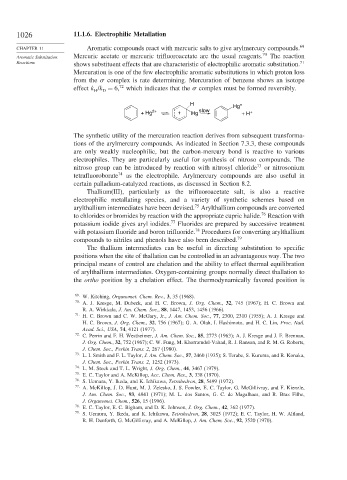Page 1050 - Advanced Organic Chemistry Part B - Reactions & Synthesis
P. 1050
1026 11.1.6. Electrophilic Metallation
CHAPTER 11 Aromatic compounds react with mercuric salts to give arylmercury compounds. 69
Aromatic Substitution Mercuric acetate or mercuric trifluoroacetate are the usual reagents. 70 The reaction
Reactions shows substituent effects that are characteristic of electrophilic aromatic substitution. 71
Mercuration is one of the few electrophilic aromatic substitutions in which proton loss
from the complex is rate determining. Mercuration of benzene shows an isotope
effect k /k = 6, 72 which indicates that the complex must be formed reversibly.
D
H
H Hg +
+
+ Hg 2+ + Hg slow + H
The synthetic utility of the mercuration reaction derives from subsequent transforma-
tions of the arylmercury compounds. As indicated in Section 7.3.3, these compounds
are only weakly nucleophilic, but the carbon-mercury bond is reactive to various
electrophiles. They are particularly useful for synthesis of nitroso compounds. The
nitroso group can be introduced by reaction with nitrosyl chloride 73 or nitrosonium
tetrafluoroborate 74 as the electrophile. Arylmercury compounds are also useful in
certain palladium-catalyzed reactions, as discussed in Section 8.2.
Thallium(III), particularly as the trifluoroacetate salt, is also a reactive
electrophilic metallating species, and a variety of synthetic schemes based on
75
arylthallium intermediates have been devised. Arylthallium compounds are converted
76
to chlorides or bromides by reaction with the appropriate cupric halide. Reaction with
potassium iodide gives aryl iodides. 77 Fluorides are prepared by successive treatment
78
with potassium fluoride and boron trifluoride. Procedures for converting arylthallium
compounds to nitriles and phenols have also been described. 79
The thallium intermediates can be useful in directing substitution to specific
positions when the site of thallation can be controlled in an advantageous way. The two
principal means of control are chelation and the ability to effect thermal equilibration
of arylthallium intermediates. Oxygen-containing groups normally direct thallation to
the ortho position by a chelation effect. The thermodynamically favored position is
69
W. Kitching, Organomet. Chem. Rev., 3, 35 (1968).
70
A. J. Kresge, M. Dubeck, and H. C. Brown, J. Org. Chem., 32, 745 (1967); H. C. Brown and
R. A. Wirkkala, J. Am. Chem. Soc., 88, 1447, 1453, 1456 (1966).
71 H. C. Brown and C. W. McGary, Jr., J. Am. Chem. Soc., 77, 2300, 2310 (1955); A. J. Kresge and
H. C. Brown, J. Org. Chem., 32, 756 (1967); G. A. Olah, I. Hashimoto, and H. C. Lin, Proc. Natl.
Acad. Sci., USA, 74, 4121 (1977).
72
C. Perrin and F. H. Westheimer, J. Am. Chem. Soc., 85, 2773 (1963); A. J. Kresge and J. F. Brennan,
J. Org. Chem., 32, 752 (1967); C. W. Fung, M. Khorramdel-Vahad, R. J. Ranson, and R. M. G. Roberts,
J. Chem. Soc., Perkin Trans. 2, 267 (1980).
73 L. I. Smith and F. L. Taylor, J. Am. Chem. Soc., 57, 2460 (1935); S. Terabe, S. Kuruma, and R. Konaka,
J. Chem. Soc., Perkin Trans. 2, 1252 (1973).
74
L. M. Stock and T. L. Wright, J. Org. Chem., 44, 3467 (1979).
75 E. C. Taylor and A. McKillop, Acc. Chem. Res., 3, 338 (1970).
76 S. Uemura, Y. Ikeda, and K. Ichikawa, Tetrahedron, 28, 5499 (1972).
77
A. McKillop, J. D. Hunt, M. J. Zelesko, J. S. Fowler, E. C. Taylor, G. McGillivray, and F. Kienzle,
J. Am. Chem. Soc., 93, 4841 (1971); M. L. dos Santos, G. C. de Magalhaes, and R. Braz Filhe,
J. Organomet. Chem., 526, 15 (1996).
78 E. C. Taylor, E. C. Bigham, and D. K. Johnson, J. Org. Chem., 42, 362 (1977).
79
S. Uemura, Y. Ikeda, and K. Ichikawa, Tetrahedron, 28, 3025 (1972); E. C. Taylor, H. W. Altland,
R. H. Danforth, G. McGillivray, and A. McKillop, J. Am. Chem. Soc., 92, 3520 (1970).

